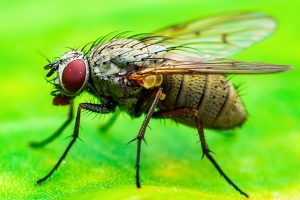Researchers led by Stein Aerts, PhD, from VIB-KU Leuven Center for Brain & Disease Research in Belgium combined single-cell technology and artificial intelligence (AI) to sketch a novel picture of gene regulation in all cells of the fruit fly brain. The team used deep learning to reveal how specific pieces of DNA steer neuronal identity from birth to maturity. The study (“Decoding gene regulation in the fly brain”) published in Nature, is expected to advance AI-driven biomedical research, especially in personalized cell-based interceptive medicine.
“The Drosophila brain is a workhorse in neuroscience. Single-cell transcriptome analysis, 3D morphological classification, and EM mapping of the connectome have revealed an immense diversity of neuronal and glial cell types that underlie an array of functional and behavioral traits in the fly,” the investigators wrote.
“The identities of these cell types are controlled by gene regulatory networks (GRNs), involving combinations of transcription factors that bind to genomic enhancers to regulate their target genes. To characterize GRNs on cell-type level in the fly brain, we profiled chromatin accessibility of 240,919 single cells spanning nine developmental timepoints and integrated this data with single-cell transcriptomes. We identify over 95,000 regulatory regions that are used in different neuronal cell types, of which 70,000 are linked to developmental trajectories involving neurogenesis, reprogramming, and maturation.
“For forty cell types, uniquely accessible regions were associated with their expressed transcription factors and downstream target genes through a combination of motif discovery, network inference, and deep learning, creating enhancer-GRNs.

“Particularly within the brain, the most complex organ, there is an immense diversity of neuronal and glial cell types that are wired together in a circuit to enable a broad range of functional and behavioral traits,” explained Aerts. “This is true for us humans, but also for tiny animals such as the fruit fly.”
Aerts’ team is specialized in decoding how DNA is used to create all the different cell types and how it drives dynamic changes in cellular states, not only in human tissue but also in fruit flies. “The fruit fly brain contains ‘only’ around 220,000 cells, a scale for which it has now become feasible to investigate the full diversity of all cell types,” added Aerts.
DNA code of enhancers is still a mystery
According to Aerts, the DNA code of enhancers is largely unknown.
“Of central importance to cell identity is the match between transcription factors and enhancers in the DNA,” he said. “Transcription factors are proteins that decode the regulatory information in our cells by recognizing enhancers, thereby making certain pieces of DNA accessible. We wanted to understand how they do that. We used a recently developed technique called single-cell assay for transposase accessible chromatin by sequencing (scATAC-seq) to identify all the enhancers that are accessible in a given cell type, at any given time.”
The Aerts lab used scATAC-seq to profile DNA accessibility of 250,000 cells during brain development at larval, pupal, and adult stages. The experiments were spearheaded by Jasper Janssens and Ibrahim Ihsan Taskiran, both doctoral candidates, and Sara Aibar, PhD. All three are early-career researchers on Aerts’ team.
“Our atlas showed that all cell types in the fly brain have unique DNA accessibility profiles, with tens of thousands of accessible regions per cell type,” noted Janssens. “We identified over 96,000 potential enhancers, covering about a third of the entire fly genome!”
“We then used deep learning to integrate this information on DNA accessibility with gene expression to construct what we call ‘enhancer-driven gene regulatory networks’,” added Aibar. “These networks explain which transcription factors bind to which enhancers to regulate particular target genes. In this way, we could predict the effect of a factor on the DNA and on cell function, and trace neuronal and glial cell types from birth to maturity.”
“With our deep learning approach, we could reveal motifs that are missed by conventional algorithms,” noted Taskiran. “As such, we identified new rules on how enhancers are built, and which sequences are important for their function.”
From flies to humans
“Of course, our results offer a starting point for much more fine-grained spatiotemporal genetic analysis in fruit flies,” said Aerts. “About two-thirds of the transcription factors in the networks we identified are linked to known brain defects or human disease, providing a foundation for follow-up studies. Indeed, brain development is surprisingly conserved through evolution!”
The building rules for enhancers revealed in this study can also be used to design enhancers that target a cell type at a specific time point, making it easier to manipulate and characterize certain cells. These novel tools will lead to a better understanding of the different neurons in the brain, pointed out Aerts. To maximize the value of these new insights for the scientific community, the researchers made all data publicly available online.
According to Aerts, this fruit fly study provides an important stepping stone for a better understanding of gene regulation in humans as well.
“Given the ongoing work in mouse and human tissue and further technological improvements, it is only a matter of time before similar networks will be derived for human brain cells as well,” he said. “These could then be used as the starting point to design enhancers for gene therapy to treat neurodegenerative diseases, for example.”
Aerts is member of a European-wide consortium aiming to track, understand, and target human cells during the onset and progression of disease, and to analyze their response to therapy at single-cell resolution.
“I am convinced that current advances in single-cell technology, deep learning, and bioinformatics will transform how we tackle medical challenges such as cancer and brain disease in our lifetime,” he concluded.






